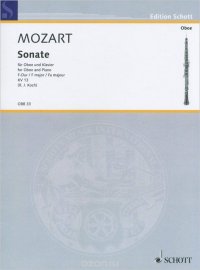With his six sonatas KV 10-15, the eight-year-old Mozart succeeded in producing 'Spielmusiken' (play pieces) of priceless quality. It is hardly conceivable that a child of this age should compose pieces which are to be taken seriously, in which his un-awakened genius is already to be detected in certain places (the slow movements amongst others), so it is not surprising that these compositions are still strongly influenced by the conventions of the time: joyful and entertaining music, written for the pleasure of performer and audience alike. The title ('Six Sonates pour le Clavecin... avec l'accompagnement de violon ou Flaute traversi?re...') implies that the instrumentation is not definitive and that performers can choose, according to the possibilities available; this reflects entirely the musical practice of the time. This, and the fortunate fact that the range of the 'accompanying' melody instrument corresponds to the range of the oboe (apart from a few low notes), together with the musical content, is reason enough for publishing these sonatas in their present form. In contrast to an arrangement for flute and piano, which has been available for some time, the piano part, in accordance with the original, is treated as an equal partner to the melody instrument, in order to achieve a balanced dialogue, especially in the slow movement. The bass part has been adhered to note for note. Parallel octaves, etc., have not been 'corrected' and, despite a few of the young Mozart's clumsy harmonies, the original has been retained as far as possible. Missing accidentals (movement II in the piano part, bars 18,41 & 42) have been added above the notes concerned. Это и многое другое вы найдете в книге Wolfgang Amadeus Mozart: Sonata F Major for Oboe and Piano: KV 13 (Wolfgang Amadeus Mozart)
Wolfgang Amadeus Mozart: Sonata F Major for Oboe and Piano: KV 13 Wolfgang Amadeus Mozart
Подробная информация о книге «Wolfgang Amadeus Mozart: Sonata F Major for Oboe and Piano: KV 13 Wolfgang Amadeus Mozart». Сайт не предоставляет возможности читать онлайн или скачать бесплатно книгу «Wolfgang Amadeus Mozart: Sonata F Major for Oboe and Piano: KV 13 Wolfgang Amadeus Mozart»
